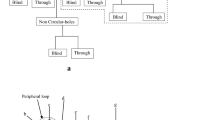Abstract
A feature recognition framework is proposed, consisting of a feature definition part and a feature matching part and operating on a B-rep model. Feature definition consists of a unique name, of a feature template yielding feature geometry, and of a set of parameter-extracting procedures yielding shape parameters. A feature template is defined in terms of building blocks and their relationships and properties. Building blocks are defined mainly in terms of profiles, their outward indexes, the types of their edges (solid/void) and their orientation. Features are classified as main and auxiliary, the former being further classified as unique and non-unique. Feature uniqueness is ensured by using key blocks that do not share elements with other feature blocks. Patterns of identical features are also identifiable. These concepts were implemented in Prolog for hole features and tested for real engineering components.
Similar content being viewed by others
References
J. Woodwark, “Computing shape: an introduction to the representation of component and assembly geometry for CAE”, ch. 3, pp. 28–36, Butterworths, 1986.
M. J. Pratt, “Synthesis of an optimal approach to form feature modelling”, in V. A. Tipnis and E. M. Patton (eds), Proceedings, 1988, ASME Conference on Computers in Engineering, San Francisco, USA, vol. 1, pp. 263–274, July 1988.
A. L. Ames, “Automated generation of uniform group technology part codes from solid model data”, in V. A. Tipnis and E. M. Patton (eds), Proceedings, 1988 ASME Conference on Computers in Engineering, San Francisco, USA vol. 1, pp. 433–437, July 1988.
G. E. M. Jared, “Shape features in geometric modelling,” in M. S. Picket and J. W. Boyse (eds)Solid Modeling by Computers — from Theory to Application, pp. 121–133, Plenum Press, New York, 1984.
L. De Floriani and E. Bruzzone, “Building a feature-based object description from a boundary model”,Computer Aided Design,21(10), pp. 602–610, December 1989.
B. K. Choi, M. M. Barash and D. C. Anderson, “Automatic recognition of machined surfaces from a 3D solid model”,Computer Aided Design,16(2), pp. 81–86, March 1984.
F. J. A. M. van Houten and A. H. van't Erve, “PART; a parallel approach to computer aided process planning”, in J. A. McGeough, (ed.) Proceedings, 4th International Conference on Computer Aided Production Engineering, Edinburgh, UK, pp. 281–288, November 1988.
M. R. Henderson, “Extraction of feature information from three dimensional CAD data”, PhD thesis, Purdue University, West Lafayette, Ind., May 1984.
H. Sakurai and D. Gossard, “Recognizing shape features in solid modelling”, IEEE Computer Graphics and Applications, pp. 22–32, September 1990.
S. Joshi and T.-C. Chang, “Graph-based heuristics for recognition of machined features from a 3D solid model”,Computer Aided Design,20(2), pp. 58–66, March 1988.
K. I. Lee, J. W. Lee and J. M. Lee, “Pattern recognition and process planning prismatic workpieces by knowledge based approach”,Annals of the CIRP,38, pp. 485–488, 1989.
J. C. E. Ferreira and S. Hinduja, “Convex hull-based feature recognition method for 2.5D components”.Computer Aided Design,22(1), 1990.
K. F. Zhang, A. J. Wright and B. J. Davies, “A feature recognition knowledge base for process planning of rotational mechanical components”,International Journal of Advanced Manufacturing Technology,7(1), pp. 13–25, 1989.
G. C. Vosniakos, “An intelligent automatic interface of Computer-Aided Design with Manufacture for 2-1/2-D prismatic parts”, PhD Thesis, UMIST, Manchester, UK, July 1991.
Anon., “Medusa NC milling demonstration”, in Proceedings, CIS Medusa European Users Conference, Cambridge, UK, May 1987.
CAM-I'sIllustrated Glossary of Workpiece Form Features, R-80-ppp-02.1, Arlington, May 1981.
S. Joshi and T.-C. Chang, “Feasible tool approach directions for machining holes in automated process planning systems”, in S. C.-Y. Liu and R. Komanduri (eds), Proceedings, Winter Annual Meeting of the ASME on Knowledge-Based Expert Systems for Manufacturing, pp. 157–169, Anaheim, USA, December 1986.
Author information
Authors and Affiliations
Rights and permissions
About this article
Cite this article
Vosniakos, G.C., Davies, B.J. A shape feature recognition framework and its application to holes in prismatic parts. Int J Adv Manuf Technol 8, 345–351 (1993). https://doi.org/10.1007/BF01751095
Accepted:
Issue Date:
DOI: https://doi.org/10.1007/BF01751095




